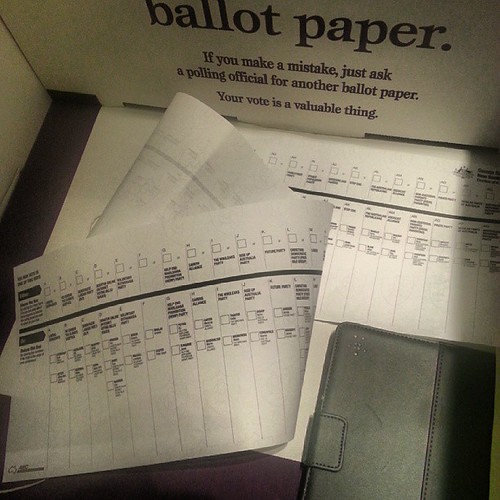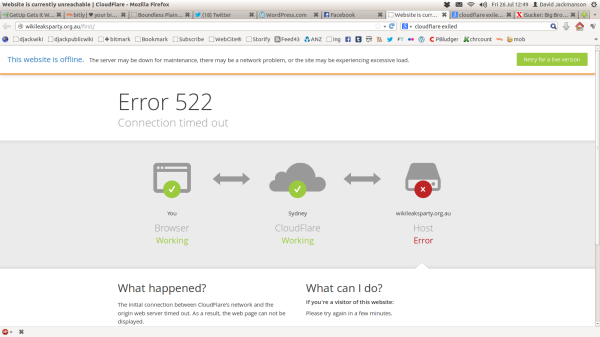UPDATE: David Leyonhjelm, the LDP’s winning Senate candidate, said today:
many punters had confused his fledgling party with the Liberals but said he was happy to take their votes.
“I don’t think everybody who voted for us though they were voting for the Liberal Democrats – maybe some thought they were voting for the Democrats, or even the Liberal party,” he said.
“We are not going to kid ourselves that 8.5 per cent of NSW thinks they were voting for the Liberal Democrats.”
—
It looks like the leading candidate and registered officer of the tiny, “libertarian” Liberal Democratic Party, David Leyonhjelm, has used a behind-the-scenes preference deal, a misleading party name and a very lucky spot on the ballot paper to win a Senate seat from New South Wales (see below for the maths). This is a scandal, and the rules need to be changed so that minor parties can no longer take control of people’s Senate votes.
Why is this a scandal?
First of all, the only reason the Liberal Democratic Party are in a position to do this is that they got about 8.7% of the vote in New South Wales. And the only way they could possibly have got a vote that high is by confusing voters into thinking they were actually the Liberal Party. The Liberal Democrats were in the very first spot on the riduculously-wide NSW Senate ballot paper:

Photo by stilgherrian, thanks for using a Creative Commons licence.
and it would clearly have been easy for voters to think they were the Liberals. The most obvious evidence for this is to look at the LDP’s votes in other states, as of 11pm on election night:
Victoria: 0.06%
Queensland: 0.64%
WA: 3.21%
SA: 3.5%
TAS: 2.29%
In 2010, the Liberal Democrats got 2.31% of the Senate vote in NSW. There is quite simply no way a 7% swing in favour of a political party would not have been picked up by Australia’s overly-busy polling industry. The only reasonable explanation is that voters were mistaken.
Secondly, Leyonhjelm has already tried to deliberately manipulate the minor-party system to get themselves into office. He is not only the registered officer of the Liberal Democrats, but also holds the same job in a totally different party, the Outdoor Recreation Party (Stop The Greens). The Smokers’ Rights Party and the Republican Party of Australia also had their preferences controlled by Leyonhjeim, as revealed by Andrew Crook in Crikey on August 22. So we have a candidate for one party controlling the preference deals of *four* different parties. Leyonjhelm was ready to make a deal with the devil to win his seat; three of those four parties made a deal with Pauline Hanson that could have seen her elected. Instead, Leyonhjelm is going to use Hanson’s votes to win.
A political party is supposed to represent a group of people who want to see some change or other in the way we are governed. It’s not meant to be a front group for a Dodgy Brothers operator with an eye for the main chance.
At the moment, the Group Voting Ticket system of Senate voting is a breeding ground for this sort of corruption of democracy. When presented with 110 candidates, most voters will choose to vote “above the line” – that is, just tick ONE box instead of writing in 1-110 next to every single candidate. When they do that, they hand their votes over to unknown backroom-artists like Leyonhjelm: the political party you vote for gets to say where the votes go if they don’t win. This encourages more and more fake parties to set up.
We need to change the rules. There is one simple rule change that could get rid of most of these parasites. All we need to do is say that if you just vote ‘1’ in the Senate for a party, they get to use your vote, but no one else does unless you clearly say so. You would say so by writing a ‘2’ in the box next to your second favourite party, if you want, and so on. If you didn’t write a ‘2’ then your vote would go no-where. This takes the power away from people you’ve never met, and puts it where it belongs, back in your own hands.
If you also think this is a scandal and it needs to stop, please say so here. Let’s raise our voices and get this issue on the agenda of the big parties.
The maths:
HOW are the Liberal Democrats going to win?
When you run for the Senate, you need about 14.7% of the vote to win a seat. When the votes are counted, they look at the percentage each party got and work out how many “quotas” each party got 1 quota is exactly the amount of votes needed to get 1 Senator elected, so in the table below you can see the ALP got 2.23 quotas and the Coalition got 2.41 quotas. This means they will each get 2 Senators elected. There are 6 seats up for grabs, so we need to figure out the last two winners.
Party
ALP 2.23 quotas, 31.9%
Coalition (COA) 2.41 quotas 34.5%
Liberal Democrats (LDP) 0.61 quotas, 8.72%
Greens (GRN) 0.54 quotas, 7.82%
Palmer United Party (PUP) 0.25 quotas, 3.62%
Democratic Labor Party (DLP), 0.10 quotas, 1.51%
Christian Democratic Party (CDP), 0.11 quotas, 1.68%
Shooters and Fishers Party (SFP) 0.09 quotas, 1.30%
One Nation (ONP), 0.08 quotas, 1.19%
The One Nation and Shooters and Fishers Party candidates will get knocked out of the race first, and their votes will got to the CDP. Then the DLP will get knocked out, and their votes will also go to the CDP, leaving ALP, Coalition, LDP, CDP, Green and PUP in the race. The ALP and Palmer United will be the next to drop out; The ALP’s votes go straight to the LDP, and the PUP votes will go to the Coalition.
This will leave four candidates running for two spots. From highest to lowest vote, they will be LDP, Coalition, Greens and CDP. The CDP will drop out, and about 0.3 of a quota will go to the LDP, and that will be enough to elect them. Then the Coalition will win the last seat.
Now these figures are early. I’m writing this on election night, and the exact amounts will change. But, as long as the total LDP vote stays higher than the combined vote of the DLP, CDP, SFP and ONP, I can’t see any way this preference flow is going to change.

